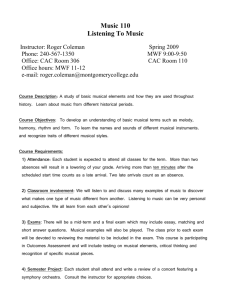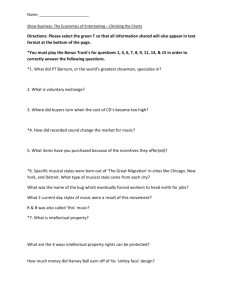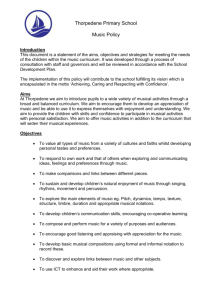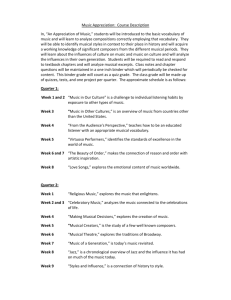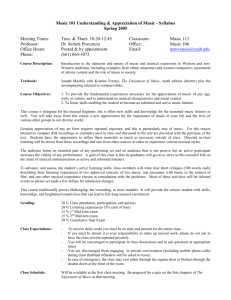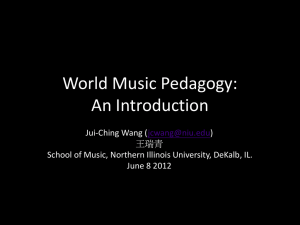Music Appreciation
advertisement
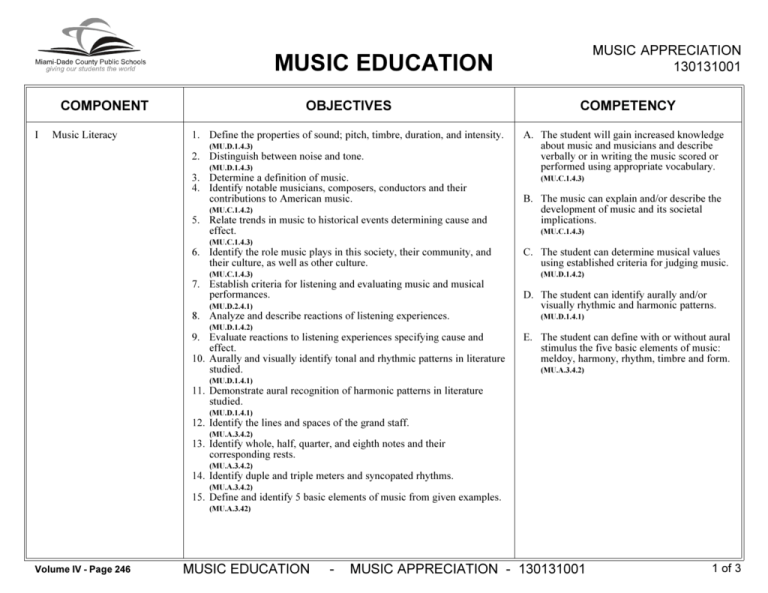
MUSIC APPRECIATION 130131001 MUSIC EDUCATION COMPONENT I Music Literacy OBJECTIVES 1. Define the properties of sound; pitch, timbre, duration, and intensity. (MU.D.1.4.3) 2. Distinguish between noise and tone. (MU.D.1.4.3) 3. Determine a definition of music. 4. Identify notable musicians, composers, conductors and their contributions to American music. (MU.C.1.4.2) 5. Relate trends in music to historical events determining cause and effect. (MU.C.1.4.3) 6. Identify the role music plays in this society, their community, and their culture, as well as other culture. (MU.C.1.4.3) 7. Establish criteria for listening and evaluating music and musical performances. (MU.D.2.4.1) 8. Analyze and describe reactions of listening experiences. (MU.D.1.4.2) 9. Evaluate reactions to listening experiences specifying cause and effect. 10. Aurally and visually identify tonal and rhythmic patterns in literature studied. COMPETENCY A. The student will gain increased knowledge about music and musicians and describe verbally or in writing the music scored or performed using appropriate vocabulary. (MU.C.1.4.3) B. The music can explain and/or describe the development of music and its societal implications. (MU.C.1.4.3) C. The student can determine musical values using established criteria for judging music. (MU.D.1.4.2) D. The student can identify aurally and/or visually rhythmic and harmonic patterns. (MU.D.1.4.1) E. The student can define with or without aural stimulus the five basic elements of music: meldoy, harmony, rhythm, timbre and form. (MU.A.3.4.2) (MU.D.1.4.1) 11. Demonstrate aural recognition of harmonic patterns in literature studied. (MU.D.1.4.1) 12. Identify the lines and spaces of the grand staff. (MU.A.3.4.2) 13. Identify whole, half, quarter, and eighth notes and their corresponding rests. (MU.A.3.4.2) 14. Identify duple and triple meters and syncopated rhythms. (MU.A.3.4.2) 15. Define and identify 5 basic elements of music from given examples. (MU.A.3.42) Volume IV - Page 246 MUSIC EDUCATION - MUSIC APPRECIATION - 130131001 1 of 3 MUSIC APPRECIATION 130131001 MUSIC EDUCATION COMPONENT II Expressive and Stylistic Characteristics OBJECTIVES 1. List characteristics of major musical styles and periods. 2. Identify from an aural stimulus major musical styles and periods. (MU.D.1.4.3) 3. Define various musical terms and expressions, identifying them from music written or heard. COMPETENCY A. Student can compare and contrast a variety of listening examples with regard to instrumentation, style, expressive characteristics and cultural context. (MU.D.1.4.2) (MU.A.3.4.2) 4. Explain cultural and historical context of music examples. (MU.C.1.1.3) 5. Identify expressive characteristics of music heard. (MU.D.1.4.3) III Forms and Structures 1. Aurally identify duple and triple meter. (MU.A.3.4.2) 2. Define basic musical forms including; binary, ternary, rondo and verse and refrain. (MU.A.3.4.2) 3. Label parts of a score and demonstrate the ability to track a selected part. A. The student can analyze a musical example with regard to phrase, meter and basic form. (MU.D.1.4.2) B. The student can identify musical components of a score. (MU.D.1.4.2) (MU.D.1.4.2) IV Technique 1. List characteristics of major musical styles and periods. (MU.C.1.4.3) 2. Explain basic information about the major periods in music history including representative composers, stylistic characteristics and selected major works. A. The student can demonstrate development of aural skills through identifying major musical styles and periods from recorded examples. (MU.C.1.4.3) (MU.C.1.4.3) 3. Identify from an aural stimulus major musical styles and periods. (MU.C.1.4.3) Volume IV - Page 247 MUSIC EDUCATION - MUSIC APPRECIATION - 130131001 2 of 3 MUSIC APPRECIATION 130131001 MUSIC EDUCATION COMPONENT V Personal and Social Musical Development OBJECTIVES 1. Establish criteria for judging music. (MU.D.2.4.1) 2. Identify a variety of musical genres, and styles to determine personal preference. (MU.E.2.4.2) 3. Determine audience behavior as a participant or performer. 4. List and describe equipment used to process music (computer, midi, synthesizer, sequence, etc.). (MU.D.1.4.2) 5. Identify various career opportunities in the community. (MU.E.2.4.3) 6. Write a report on music related careers. (MU.E.2.4.3) 7. List factors to be considered in choosing a career in music. (MU.E.2.3.1) 8. Analyze the discipline, knowledge, and skills required for career preparation in music. (MU.E.2.3.3) 9. Explain the function of the music union (AFM) agents, placement services, copyright applications, and contracts. (MU.E.2.3.1) 10. Prepare a budget for a concert. (MU.E.2.3.3) COMPETENCY A. The student can make informed judgements about music using established criteria to justify personal preference. (MU.E.2.4.2) B. The student can demonstrate appropriate audience behavior. C. The student can describe how to apply technology to process music. (MU.D.1.4.2) D. the student can identify careers that relate to the music field. (MU.E.2.4.3) E. The students can discuss the requirements for a career in music. (MU.E.2.3.1) F. The student can complete a research project about his/her music career interest. (MU.E.2.3.3) G. The student can complete a budget for a concert event. (MU.E.2.3.3) Volume IV - Page 248 MUSIC EDUCATION - MUSIC APPRECIATION - 130131001 3 of 3

